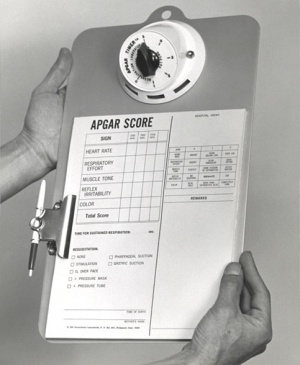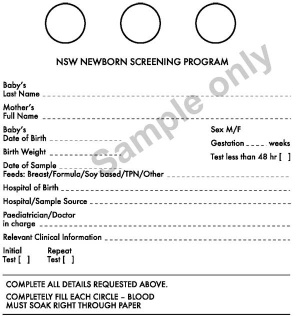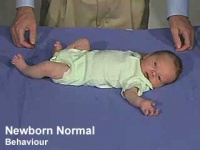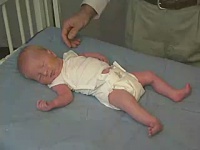BGDA Practical 12 - Neonatal
| Practical 12: Embryo to Fetus | Second Trimester | Third Trimester | Birth | Neonatal | Abnormalities |
Introduction
The neonatal period (birth to 1 month) is a time of extensive and ongoing system transition from uterine environment to external world, this includes the initial period after birth which is referred to as the perinatal period.
It would seem obvious to say that development does not stop at birth. In fact many systems (cardiovascular, respiratory, gastrointestinal, homeostasis) undergo significant changes at birth, and many others (neural) have not yet completed their development. Note this current project focuses on prenatal development, so postnatal content is not as detailed.
Newborn Homoeostasis
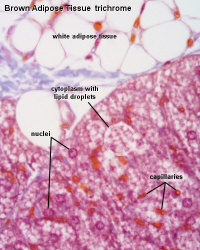
Brown adipose tissue |
Newborn has to establish new functioning systems in a balanced and regulated manner (homoeostasis).
Glucocorticoids - have an important role in the preparation for birth, including involvement in lung and cardiac development, and the maturation of enzymes in a variety of pathways. Puerperium - The six weeks following parturition (birth) when maternal reproductive organs and physiology return to pre-pregnant state. |
Respiration
| Postnatal alveoli number | Neonatal rib orientation |
|---|---|
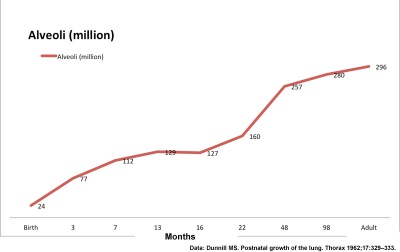
|

|
|
|
Cardiovascular
- Umbilical Vasculature - The umbilical blood vessel cavity is lost postnatally over the course of weeks to months after birth. The adult anatomical remnant of the umbilical vein between the umbilicus and liver is the ligamentum teres.
- Foramen Ovale - two separate forms of foramen ovale closure; functional and structural. Functional closure begins at the first breath and is rapid. Structural (anatomical) closure is much slower and generally occurs before the end of the first year.
- Ductus Arteriosus - a direct connection between the pulmonary trunk and the dorsal aorta. Postnatal closure occurs initially by by smooth muscle contraction and begins at the first breath and is rapid, completed within the first day (about 15 hr after birth). Anatomical closure is much slower occuring by 2–3 weeks after birth (33% of infants), by 2 months (90% of infants) and by 1 year (99% of infants). The adult anatomical remnant of the ductus arteriosus is the ligamentum arteriosum.
- Ductus Venosus - connects portal and umbilical blood to the inferior vena cava. Functional closure occurs postnatally within hours. Structural closure commences days after birth and completes by 18 to 20 days. The adult anatomical remnant of the ductus venosus is the ligamentum venosum (a dorsal fissure on the liver).
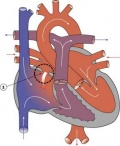
|
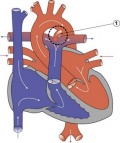
| ||
| Fetal Circulation | Neonatal Circulation | Atrial Septal Defect | Patent Ductus Arteriosus |
Neonatal Testing
Apgar Test
A historic neonatal test designed by Dr Virginia Apgar used in nearly all maternity clinics to assess the newborn infants well being assigned scores for each of 5 indicators: Heart Rate, Respiratory Effort, Reflex Irritability, Muscle Tone, Colour Measured at one and five minutes after birth the Score values are totalled for all indicators: 7-10 is considered normal, 4-7 may require resuscitative measures, 3 and below require immediate resuscitation. In recent years there has been some controversy of the relevance and accuracy of some of the criteria used in this test, though many feel it is still an invaluable initial assessment tool particularly where medical services are limited.
| Indicator | Score 0 | Score 1 | Score 2 |
| Activity (muscle tone) |
Limp; no movement | Some flexion of arms and legs | Active motion |
| Pulse (heart rate) |
No heart rate | Fewer than 100 beats per minute | At least 100 beats per minute |
| Grimace (reflex response) |
No response to airways being suctioned | Grimace during suctioning | Grimace and pull away, cough, or sneeze during suctioning |
| Appearance (color) |
The baby's whole body is completely bluish-gray or pale | Good color in body with bluish hands or feet | Good color all over |
| Respiration (breathing) |
Not breathing | Weak cry; may sound like whimpering, slow or irregular breathing | Good, strong cry; normal rate and effort of breathing |
| Table data[1] Apgar test - Measured at one and five minutes after birth, the score values are totalled for all indicators: | |||
| Total Score: | 3 and below require immediate resuscitation | 4 to 7 may require resuscitative measures | 7 to 10 is considered normal |
|---|---|---|---|
- Links: Apgar test
Bloodspot Test or Guthrie Test
A blood screening test developed by Dr Robert Guthrie (1916-95) at University of Buffalo. The test is carried out on neonatal (newborn) blood detecting markers for a variety of known disorders (phenylketonuria (PKU), hypothyroidism and cystic fibrosis). In NSW and Victoria, the Guthrie Cards are currently stored indefinitely.
GUTHRIE R & SUSI A. (1963). A SIMPLE PHENYLALANINE METHOD FOR DETECTING PHENYLKETONURIA IN LARGE POPULATIONS OF NEWBORN INFANTS. Pediatrics , 32, 338-43. PMID: 14063511
NSW Newborn Screening Programme
Each year test more than 90,000 babies and detects about 90 who need urgent assessment and treatment.
- Phenylketonuria (PKU) - 1 in 10,000 live births (about 10 babies per year). PKU causes high blood levels of phenylalanine and severe intellectual disability. A diet low in phenylalanine, started in the first two to three weeks results in normal development.
- Primary congenital hypothyroidism - 1 in 3,500 live births (about 26 babies per year). It is caused by the absence or abnormal formation or function of the thyroid gland. This causes growth and intellectual disability if not treated. Medication with thyroid hormone started early, results in normal growth and development.
- Cystic Fibrosis (CF) - 1 in 2,500 live births (about 34 babies per year). Without treatment babies develop chest infections and often have very serious failure to thrive. Early institution of treatment greatly improves the health of babies with CF. Newborn bloodspot screening detects about 95% of babies with CF but also detects a few babies who may only be healthy carriers. For these babies a sweat test at about six weeks of age determines whether the baby has CF or is a healthy carrier.
- Galactosaemia - 1 in 40,000 births (about 1-3 cases per year). Babies cannot process galactose, a component of lactose. Life-threatening liver failure and infections can occur. A galactose-free diet instituted in the first week is life saving.
- Rarer metabolic disorders - Some fatty acid, organic acid and other amino acid defects can now be detected using Tandem Mass Spectrometry. These much rarer metabolic disorders affect about 15 – 18 babies per year. Early detection is important as diet and medications can treat most of these disorders. Without appropriate management they can cause severe disability or death.
Genetics services in NSW - coordinated by the NSW Genetics Service Advisory Committee, which is supported by the Statewide Services Development Branch of the Strategic Development Division, NSW Department of Health. (Information from NSW Health - Newborn Bloodspot Screening Policy 13-Nov-2006)
- Links: Guthrie test | NSW Genetics Health
Neonatal Interactive Component
| Attempt the Quiz - Neonatal Development | ||
|---|---|---|

Here are a few simple Quiz questions that relate to Neonatal development from the practical.
t
|
| Practical 12: Embryo to Fetus | Second Trimester | Third Trimester | Birth | Neonatal | Abnormalities |
Additional Information
| Additional Information - Content shown under this heading is not part of the material covered in this class. It is provided for those students who would like to know about some concepts or current research in topics related to the current class page. |
Links: birth | Postnatal Development | puberty
Newborn Infant Skin
Visscher MO, Adam R, Brink S & Odio M. (2015). Newborn infant skin: physiology, development, and care. Clin. Dermatol. , 33, 271-80. PMID: 25889127 DOI.
- "Infant skin is critical to the newborn child's transition from the womb environment to the journey to self-sufficiency. This review provides an integrative perspective on the skin development in full term and premature infants. There is a particular focus on the role of vernix caseosa and on the implications of skin development for epidermal penetration of exogenous compounds. Healthy full-term newborn skin is well-developed and functional at birth, with a thick epidermis and well-formed stratum corneum (SC) layers. Transepidermal water loss is very low at birth, equal to, or lower than adults, indicating a highly effective skin barrier. Vernix facilitates SC development in full-term infants through a variety of mechanisms including physical protection from amniotic fluid and enzymes, antimicrobial effects, skin surface pH lowering, provision of lipids, and hydration. Premature infants, particularly those of very low birth weight, have a poor skin barrier with few cornified layers and deficient dermal proteins. They are at increased risk for skin damage, increased permeability to exogenous agents and infection. The SC barrier develops rapidly after birth but complete maturation requires weeks to months."
Developmental Hip Dysplasia
- DDH affects between 1-7% of infants.
- Risk factors include - family history, female sex, breech positioning, and higher birth weight.
- All infants should be examined.
- Selective screening and imaging for abnormal physical exams or teh above risk factors.
- Early (neonatal) treatment has been associated with optimal outcomes.
Barlow test
(Barlow maneuver) clinical physical newborn examination where the examiner adducts the hip (bringing the thigh towards the midline) while applying light pressure on the knee, directing the force posteriorly. A positive sign is the hip being dislocatable, if the hip can be popped out of socket with this test.
Ortolani test
(Ortolani maneuver) clinical physical newborn examination for posterior dislocation of the hip. Using the examiner's thumb, abduct the infant's leg, while using the examiner's index finger to place anterior pressure on the greater trochanter. A positive sign is a distinctive 'clunk' which can be heard and felt as the femoral head relocates anteriorly into the acetabulum, usually becomes negative after 2 months of age.
Links: developmental hip dysplasia
Neonatal Neural Exam
Babinski reflex - (plantar reflex) The up going toes or “Babinski reflex” normal reflex in the infant and may be present for the first year of life because at that developmental stage the incomplete myelination of the corticospinal tracts.
The collapsed tables below link to a number of short videos that demonstrate simple assessments of the postnatal developing nervous system.
|
| ||||||||||||||||||||||||||||||||||||||||||||||||||||||||||||||||||||||||||||||||||||||||||||||||||||||||||||||||||||||||||||||||||||||||||||||||||||||||||||||||||||||||||||||||||||||||||||||||||||||||||||||||||||||||||||||||||||||||||||||
Immunisation
| Australian Child Immunisation Programs 2013 | |
|---|---|
| Age | Vaccine |
| Birth |
|
| 2 months |
|
| 4 months |
|
| 6 months |
|
| 12 months |
|
| 18 months |
|
| 4 years |
|
| Notes: | Information provided for educational purposes only. Postnatal - Vaccination | Immunise Australia Program
a Hepatitis B vaccine: should be given to all infants as soon as practicable after birth. The greatest benefit is if given within 24 hours, and must be given within 7 days. b Rotavirus vaccine: third dose of vaccine is dependent on vaccine brand used. |
| Source: | Australian Immunisation Handbook 10th edition (April 2013).[2] National Immunisation Program Schedule From 1 February 2013 to 30 June 2013 PDF Immunise Australia Program. |
BGDA: Lecture 1 | Lecture 2 | Practical 3 | Practical 6 | Practical 12 | Lecture Neural | Practical 14 | Histology Support - Female | Male | Tutorial
Glossary Links
- Glossary: A | B | C | D | E | F | G | H | I | J | K | L | M | N | O | P | Q | R | S | T | U | V | W | X | Y | Z | Numbers | Symbols | Term Link
Cite this page: Hill, M.A. (2024, April 27) Embryology BGDA Practical 12 - Neonatal. Retrieved from https://embryology.med.unsw.edu.au/embryology/index.php/BGDA_Practical_12_-_Neonatal
- © Dr Mark Hill 2024, UNSW Embryology ISBN: 978 0 7334 2609 4 - UNSW CRICOS Provider Code No. 00098G
- ↑ APGAR V. (1953). A proposal for a new method of evaluation of the newborn infant. Curr Res Anesth Analg , 32, 260-7. PMID: 13083014
- ↑ Australian Immunisation Handbook 10th edition (April 2013) Immunise Australia Program

